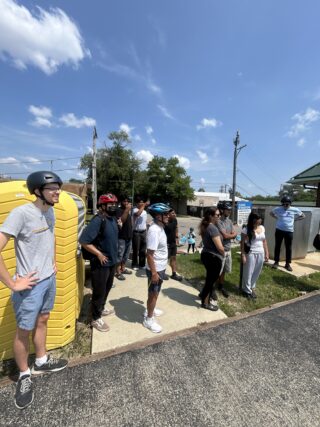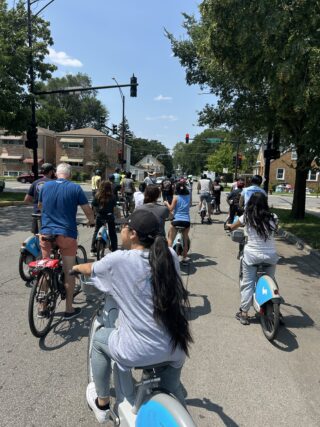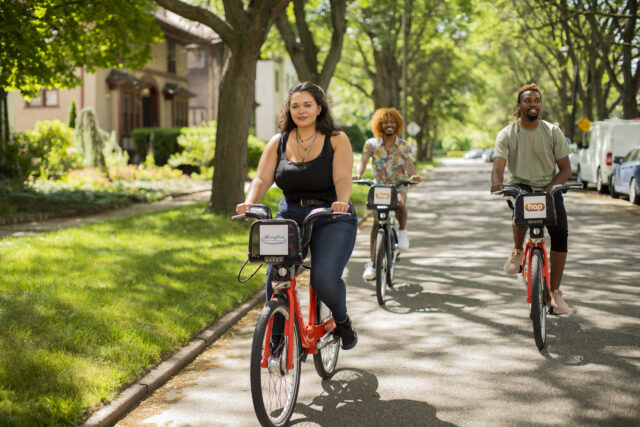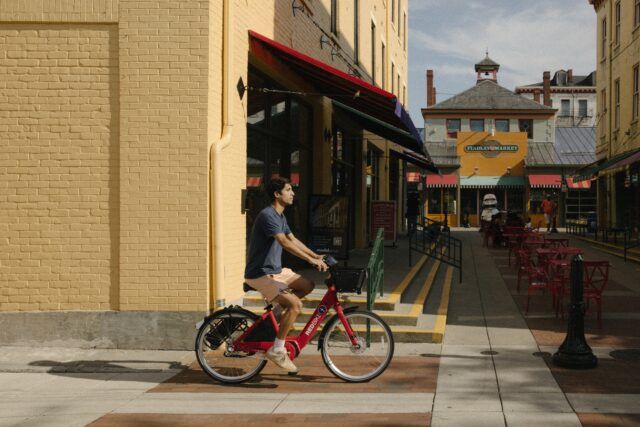Where Are They Now? Hear From BBSP’s Past Living Lab Grantees
by Odochi Akwani, Writer and Content Manager
October 16, 2025
BBSP was excited to connect with some of our past Living Labs cities to share how their work has evolved since completing the program.
This week, we’re catching up with three of our past Living Labs grantees— Jeremy Cuebas, formerly with the Northwest Center in Chicago, Jacob Graham with MoGo Detroit, and Doug McClintock with Red Bike in Cincinnati. Each of these individuals led their Living Lab work as part of larger collaborative efforts involving various partners in each of their cities. Each lab focused on strategies to promote equity in shared micromobility for low-income and communities of color, receiving $200,000 in funding, network support, and additional resources over a two-and-a-half-year period.
In this blog, we’ve captured how the grantees have shifted and changed in their work since the conclusion of their labs in 2023.
CHICAGO


The Northwest Center, a nonprofit based in the Belmont Cragin neighborhood, led the Chicago lab. In their work, led by Jeremy Cuebas, a youth organizer at the time, they implemented a a youth-led outreach campaign to empower youth in Belmont Cragin to lead bike-related programs to connect the neighborhood to transit, jobs, schools, and each other.
Since then, Cuebas was laid off from The Northwest Center due to federal grants being frozen and paused. He believed there was still a gap that needed to be filled in this neighborhood regarding youth engagement and transportation which inspired him to create the nonprofit Grassroots Empowerment Mission (GEM).
“It was started by me and a group of young people who saw what was going on at the federal level, and me losing my job, and them saying, ‘Hey, what’s going to happen with this work?’ ‘What will happen with the transportation advocacy work in the community?’ This agitated us enough to start GEM,” says Cuebas.
GEM’s mission is to ‘transform communities by empowering young leaders to take action and create lasting change.’ One way it accomplishes that is through its Next GEM Leaders program. Through that program, youth are working on various civic engagement-related projects. One project is with the Active Transportation Alliance. GEM is mobilizing young people on the Northwest side of the city for a campaign called the Clean & Equitable Transportation Act, which is a statewide campaign to make the public transportation system in Illinois work better. GEM youth are gathering stories from people who use public transportation daily to understand their needs. As the city faces 40% service cuts and increased fares, GEM is asking residents how that may affect them if the state doesn’t fund public transportation.
Another key aspect of GEM’s programming is education. The young people wanted to get trained on how to effectively organize, so Cuebas teamed up with the Southwest Organizing Project to develop a curriculum for grassroots organizing, media training, and public versus private relationships.
“I think what has been a good reward is my relationships with our elected officials transferred over to GEM,” says Cuebas. “Another reward is our continuous involvement within the community. Even with transitioning to GEM, people trust me and the youth. We built that trust over time, and people trust us, so they’re willing to join a campaign or join the next GEM Leader Program and continue the work.”
DETROIT

MoGo in Detroit focused on first- last-mile connections, specifically their bike-to-bus connection by transit and bike share integration. Throughout the lab, they were laying the groundwork by building connections with the Suburban Mobility Authority for Regional Transportation and with the Regional Transit Authority of Southeast Michigan to make this a reality. This integration on the Transit App is launching this month.
“The transit app will be live for all of the transit systems in the metro region, which is just going to be huge, to be able to buy a bike share pass in the same app as a bus pass,” says Jacob Graham, executive director of MoGo.
Additionally, the city is replacing all of its fare boxes in its buses, and those are going to have increased functionality with tap-to-pay and QR code functionality. This is big for MoGo as the buses will now be using the same RFID technology as the bike share system. This makes the case for a coordinated pass between all types of transportation in the future, after this testing period of making sure the new fare boxes are working efficiently.
For Graham, the Living Lab allowed him to learn from other systems in the industry to see how they have integrated.
“Portland has done a lot as far as coordinating between their bus network and their train network, and their bike share network—just as an example of how it can be done differently,” says Graham. “They were a huge inspiration for us. The Living Lab closeout event that we had in Chicago, just seeing how their bus fare payment worked in Chicago, was really cool to see how easy it was to do tap to pay.”
These connections were especially valuable as a nonprofit bike share system.
“There aren’t a lot of nonprofit bike shares these days, and so it’s been great to have a continued connection with Doug in Cincinnati and just be able to talk shop,” says Graham. “That connection really came from the Living Lab project. In this funding environment, we have to continue to evolve and seek new revenue streams. So, it’s been great to have other people experiencing the same kinds of issues, to be able to talk that through.”
CINCINNATI

Cincinnati’s Red Bike focused on expansion for its Living Lab project, namely with its youth programming, community partnerships, and its low-income GO Pass program. They’ve had an interesting time, to say the least, since the end of their Living Lab.
“We started anticipating a pretty big funding crisis for the organization,” says Doug McClintock, executive director of Red Bike. “The funding crisis was that our presenting sponsor, who had been with us since our founding for eight years, was no longer renewing their sponsorship. So, it really created a financial hardship for the business as we entered 2023.”
Red Bike was able to get through its 2023 season, but in 2024, it paused service for about five months while it searched for additional funding.
“Thankfully, we had a group of people come together and fund the business for 2024, so we launched again in the middle of May,” says McClintock. “We turned everything back on and worked through 2024, but the primary work that we were doing in 2024, aside from running bike share, was working with those partners and a consultant to really look at the business and say, ‘Hey, what’s right, what’s wrong? How are we performing compared to other folks, and ultimately, what is the right structure for Cincinnati to make sure the bike share remains?’
One of the things that came up was how Red Bike’s low-income GO Pass program was a “financial drag,” according to McClintock. In 2024, 55% of their rides were from GO Pass members, and this year, 50% of their rides have been from GO Pass members. The Go pass membership count is up 80% since 2023. This speaks to the partnerships Red Bike has cultivated over the years and how ingrained this program is within Red Bike. Because of this, Red Bike is workshopping how to continue this program through other revenue sources.
This May, Red Bike announced its “Strengthen and Sustain” funding plan, which will fund the system for three years thanks to a partnership with The City of Cincinnati, Cincinnati Metro, Interact For Health, Greater Cincinnati Foundation, P&G, The United Way, and Northern Kentucky business and civic leaders.
In Red Bike’s partnership with their transit agency, Cincinnati Metro, they’ve been looking at first-last mile solutions, because the city will be implementing bus rapid transit starting in 2027. Red Bike is planning stations to benefit its current system and align for greater connectivity to the future bus rapid transit system. For this, Red Bike is focused on the Avondale neighborhood, which was the focus of their outreach and engagement during their lab, to connect them to the trail infrastructure and the bus rapid transit that will go through there.
“We are starting to create deeper connections with transit, deeper connections across the Ohio River to Northern Kentucky, and there are more conversations about inclusion of our program,” says McClintock. “We have the chance to also drive the conversation around equity every time, because it’s not just about serving people who can afford this, right? It’s about making sure that we’re serving the entire public.”
For McClintock, he stumbled into leading Red Bike’s Living Lab, landing the executive director role in Fall 2022, toward the end of the program.
“I took the executive director position, and I didn’t know how it would change my life,” says McClintock. “Truly, the Living Lab changed me as a person because I was exposed to perspectives that I wasn’t necessarily prepared to hear. I will forever be indebted that this is one of the things that happened in my life.”
___________________________________________________________________________________________
The Better Bike Share Partnership is funded by The JPB Foundation as a collaboration between the City of Philadelphia, the National Association of City Transportation Officials (NACTO), and the PeopleForBikes Foundation to build equitable and replicable bike share systems. Follow us on LinkedIn, Facebook, Twitter, and Instagram, or sign up for our weekly newsletter.
Have a question or a story idea? Email odochi@peopleforbikes.org.
